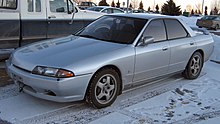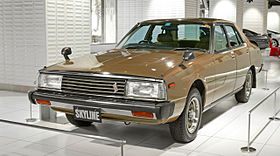The names were brought into line with the home Japanese and worldwide
markets with the launch of the R30 series in August 1981, which was
built on a C31
Laurel
platform. Unlike preceding generations, four- and six-cylinder versions
now shared a front end of the same length. The R30 was available as a
two-door hardtop
coupe, a four-door
sedan, a five-door
hatchback (available only in the R30 generation), or a four-door
station wagon. In all, there were 26 variations of the R30 Skyline available.
All versions with the exception of the wagon were usually fitted with
the four round tail lights that had become a regular feature to the
Skyline's design. The wagon had different tail lights, headlights, and
no turbo or six-cylinder versions available. It more closely resembled a
Nissan Sunny than a Skyline. The two-door coupé had a
hardtop,
pillarless design, and featured roll-down quarter windows for the rear
seat passengers (a styling feature of the previous C10, C110, and C211
coupes), while four-door versions had a traditional sedan body style
with framed windows.
Notably, configurations of the R30 sold in Australia and New Zealand
were missing the traditional hotplate tail lights, instead opting for
more conventional styling. Export markets also received some larger
(albeit less powerful) engines, in the form of 2.4 and a 2.8 liter
inline-sixes of 120 PS (88 kW) or 139 PS (102 kW). The 2.8 was added in September 1982.
Various engine configurations were available, initially ranging from the top of the line 103 kW SOHC 6-cylinder turbo
L20ET to the 4-cylinder Z18S and 6-cylinder LD28 diesel versions at the other end of the scale. The all-new
16-valve DOHC FJ20
engine debuted in late 1981, and was the first four-cylinder engine
from any Japanese manufacturer to employ more than two valves per
cylinder (see below). Some of the top spec models featured adjustable
suspension dampers that could be adjusted while driving, this was
another first for mass-produced JDM vehicles. Nissan Glorias and Laurels
also used the L series engines, as well as some diesel (Laurel only)
variants.
The R30 range was facelifted in August 1983 with various changes across the board; for example four-wheel
disc brakes
were now standard issue, instead of being optional for lower-spec
models. Trim specifications were revised and the 4-cylinder Z18S engine
was replaced with the newer CA18E. Features included upgraded interior
trim, new front and rear bumpers, door-mounted wing mirrors (replacing
the old 'hockey stick' fender mirrors), and smoked tail lights.
Paul Newman Version
During 1983 the
Paul Newman Version R30 was released to commemorate the association between Nissan and the actor
Paul Newman,
who used to appear in promotional material, as well as race for the
company during the late-1970s and early-1980s. The Newman Skyline was
simply a top spec GT-ES turbo with signature embroidery and decals.
RS
Facelift DR30 RS-Turbo Skyline, nicknamed "Iron Mask" for its distinctive front end treatment
Although making about the same power as the L20ET-powered
GT-ES models, the version of the Skyline initially known as the
2000RS
was released on October 2, 1981 as more of a stripped-down lightweight
racer, without as many luxury extras included (quoted curb weight was
only 1,130 kg (2,490 lb)). These were equipped with the naturally
aspirated 4-valve-per-cylinder DOHC
FJ20E
engine generating 110 kW (150 PS; 148 hp) of power at 6,000 rpm and
181 N·m (133 lb·ft) of torque at 4,800 rpm. The official Nissan chassis
designation for all FJ20-powered models was
DR30.
In February 1983 the DR30 range received a significant boost in performance with the introduction of the turbocharged
FJ20ET engine in the
2000RS-Turbo.
Front brakes were also significantly upgraded to cope with the power
increase. Now with 140 kW (190 PS; 188 hp) of power at 6,400 rpm and
225 N·m (166 lb·ft) of torque at 4,800 rpm on tap, the FJ20ET enjoyed
new-found prestige as the most powerful Japanese production engine of
its era.
Nissan sought to elevate the status of the DR30 Skyline as their new
flagship model in light of this success, and it received a generous
amount of changes to distinguish it from lesser Skyline models in August
1983. Interior equipment was significantly upgraded to now include
electric windows, air conditioning and power steering as standard in the
new RS-X model (for Extra) with an increased curb weight of around
1,235 kg (2,723 lb); gone were the days of the spartan, stripped-out
race interior, although this could still be specified at time of
purchase. But by far the most striking change to the RS was the new
unique front end treatment, nicknamed
Tekkamen (
鉄仮面) or
Iron Mask
by fans for its distinctive look. The headlights were considerably
slimmer, and instead of a conventional grille the bonnet now sloped down
to two narrow slits above a facelifted front bumper and airdam.
Further changes were made in 1984, most notably the addition of an
intercooler, revised compression ratios and turbocharger exhaust housing
to the
FJ20ET powered model, now known as the
RS-Turbo C
and increasing output to 205 PS (151 kW) of power at 6,400 rpm and
245 N·m (181 lb·ft) of torque at 4400 rpm. An automatic transmission
option was also added at this time, and changes to the "PLASMA Spark"
ignition system followed in early 1985 towards the end of R30
production.
Nissan Skyline (R30) van (Japan)
To this day the FJ20-powered R30 Skyline remains a cult car both at
home and overseas (there are still dedicated "one make" drag racing
events for this model in Japan), and is credited with rejuvenating the
Skyline brand in the early 1980s. It also paved the way for the eventual
re-introduction of the legendary GT-R badge, markedly absent since the
end of C110 Skyline production in 1973.
The DR30 achieved success in Australian
touring car racing during the mid-1980s. The factory backed
Peter Jackson Nissan Team made its
Group A debut in the opening round of the
1986 Australian Touring Car Championship, and over the 10 round series, lead driver
George Fury
would win four of the rounds and it was only unreliability in the first
two rounds that cost Fury the title, finishing only 5 points behind the
Volvo 240T of
Robbie Francevic. Fury then went on to finish second to the
BMW of
Jim Richards in the
1986 Australian Endurance Championship, winning four of the six rounds, though failures to finish in the opening round at
Amaroo Park in
Sydney, as well as a DNF at the
James Hardie 1000 at
Bathurst cost him the title. Team driver
Garry Scott would put the DR30 on pole for the James Hardie 1000 before going on to finish third with young charger
Glenn Seton.Despite missing out on the drivers title, Nissan would win the
1986 Australian Manufacturers' Championship from BMW. Fury finished off 1986 by finishing second to the
V8 Holden Commodore of
Allan Grice in the Group A support race for the
Australian Grand Prix in
Adelaide.
Fury was joined in
1987 Australian Touring Car Championship by Glenn Seton. While Fury had a frustrating first half of the championship, Seton would battle it out with the
BMW M3 of Richards for the title. The series came down to the last race at Sydney's
Oran Park Raceway where Richards used the nimble M3 to defeat Seton and win his second
ATCC in three years. With Fury finishing third in the championship, this saw Nissan sharing victory with
BMW in the
1987 Australian Manufacturers' Championship.
The final competitive race for the Peter Jackson Nissan DR30's came in the Group A support race for the
1987 Australian Grand Prix in Adelaide where Fury again finished second behind the
Ford Sierra RS500 of
Dick Johnson.
The 340 bhp (254 kW; 345 PS) DR30 continued to be used by privateer racers in Australian touring car racing until 1989



















